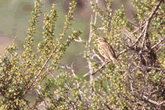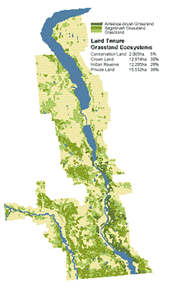|
(published
1998)
Habitat Atlas
for Wildlife at Risk
Grassland Ecosystems
 Grasslands,
or steppes, are ecosystems dominated by perennial grasses
with scattered shrubs and a soil crust of lichens and
mosses. South Okanagan grasslands are divided into two
broad ecosystems: bunchgrass and shrub-steppe. The shrub-steppe
grasslands occur in the hottest and driest environments
of the valley bottoms, and are further divided into
sagebrush steppe and antelope-brush steppe. All of these
different habitats have their own animal specialists,
but they also share many species between them. Grasslands,
or steppes, are ecosystems dominated by perennial grasses
with scattered shrubs and a soil crust of lichens and
mosses. South Okanagan grasslands are divided into two
broad ecosystems: bunchgrass and shrub-steppe. The shrub-steppe
grasslands occur in the hottest and driest environments
of the valley bottoms, and are further divided into
sagebrush steppe and antelope-brush steppe. All of these
different habitats have their own animal specialists,
but they also share many species between them.
One of the most critically endangered
plant communities in Canada is the Antelope-brush grassland
found mainly on the east side of the Okanagan Valley
north to Skaha Lake. Less than 40 percent of this habitat
now remains in the South Okanagan. Recent large-scale
land clearing for vineyards continues to reduce the
small amount remaining.
 Grasslands,
which cover 27 percent of the South Okanagan and Lower
Similkameen, have been heavily impacted by livestock
grazing, agriculture, and urban development. Poor cattle
grazing practices in the early part of the Twentieth
Century badly degraded grasslands. Although the grasslands
are in better condition today, good range management
practices are needed to maintain this improving trend.
Weeds pose another threat to the integrity of grasslands,
colonizing disturbed sites and dispersing to surrounding
areas. Grasslands,
which cover 27 percent of the South Okanagan and Lower
Similkameen, have been heavily impacted by livestock
grazing, agriculture, and urban development. Poor cattle
grazing practices in the early part of the Twentieth
Century badly degraded grasslands. Although the grasslands
are in better condition today, good range management
practices are needed to maintain this improving trend.
Weeds pose another threat to the integrity of grasslands,
colonizing disturbed sites and dispersing to surrounding
areas.
More than half (31 out of 57) of the Red and Blue-listed
species in the South Okanagan and Lower Similkameen
are associated with grasslands. Twelve of 35 rare plant
communities are also associated with grasslands. Many
insect species unique to the Okanagan in Canada are
grassland specialists. All of the vertebrate species
that have disappeared from the this area in the last
century were grassland species: pigmy short-horned lizard,
white-tailed jackrabbit, Sage Grouse, Sharp-tailed Grouse,
and Burrowing Owl.
Antelope-brush Habitat
 Less
than 40 percent of the rare antelope-brush (Purshia
tridentata, bitterbrush or greasewood) habitat now remains
in the South Okanagan; it is not found in the Similkameen
and almost none occurs north of Skaha Lake. Recent large-scale
land clearing of this habitat for vineyards continues
to erode the small amount remaining. In the South Okanagan,
less than 5 percent of grassland ecosystems are protected
in some form; another Less
than 40 percent of the rare antelope-brush (Purshia
tridentata, bitterbrush or greasewood) habitat now remains
in the South Okanagan; it is not found in the Similkameen
and almost none occurs north of Skaha Lake. Recent large-scale
land clearing of this habitat for vineyards continues
to erode the small amount remaining. In the South Okanagan,
less than 5 percent of grassland ecosystems are protected
in some form; another  30
percent is on Crown land. Most of the remaining undeveloped
grassland is on Indian Reserves (29 percent) or private
lands (36 percent). 30
percent is on Crown land. Most of the remaining undeveloped
grassland is on Indian Reserves (29 percent) or private
lands (36 percent).
Threats:
- Low elevation grasslands are subject to development
pressure from the expanding population and rapidly
growing wine industry.
- The remaining grasslands are fragmented and may
suffer from loss of species along their borders (edge
effect) due to disturbance from adjacent developed
areas.
- Some grassland areas have been cleared of shrubs
and burned for "improvement."
- Weed invasion and off-road vehicle activity can
further degrade this ecosystem.
- Grasslands take a long time to recover from disturbance
due to slow plant growth and high soil sensitivity.
Grassland Wildlife at Risk:
Red List
- Brewer's Sparrow
- Burrowing Owl
- Ferruginous Hawk
- Grasshopper Sparrow
- Prairie Falcon
- Sage Thrasher
- Lark Sparrow
- Pallid Bat
- Badger
- Western Harvest Mouse
|
Blue List
- Gopher Snake
- Western Rattlesnake
- Racer
- Lark Sparrow
- Long-billed Curlew
- Swainson's Hawk
- California Bighorn Sheep
- Great Basin Pocket Mouse
- Nuttall's Cottontail
|

|